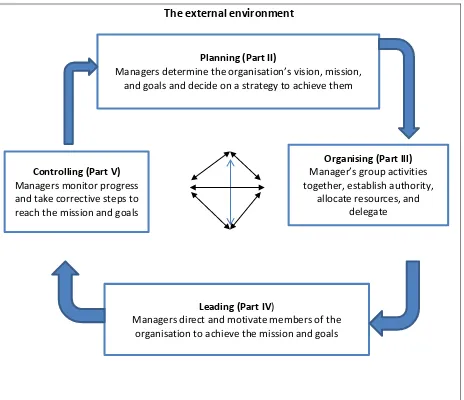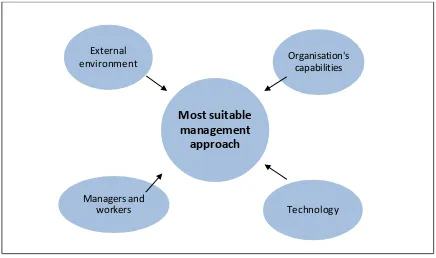Informasi Dokumen
- Sekolah: Richfield Graduate Institute of Technology
- Mata Pelajaran: Business Management
- Topik: Business Management 621 Year 2 Semester 1
- Tipe: study guide
- Tahun: 2016
- Kota: Cape Town
Ringkasan Dokumen
I. Section A: Preface
This section provides an introduction to the Business Management 621 module, outlining its purpose, learning outcomes, study methods, assessment criteria, and resources. It sets the stage for the semester by familiarizing students with the course structure, expectations, and support systems available. The welcome message emphasizes the module's relevance to students' future careers. The inclusion of a detailed table of contents aids navigation and allows for a systematic approach to understanding the module's scope. The emphasis on prescribed and recommended materials underscores the importance of active learning and engagement with the subject matter.
1.1 Welcome
This subsection offers a welcoming introduction to the Department of Business, Economics, and Management Sciences, highlighting the module's engaging and insightful nature. It also briefly explains the purpose of the preface in orienting students to the course before lectures begin, setting a positive and supportive tone for the upcoming academic journey.
1.2 Title of Module, Code, NQF Level, Credits & Mode of Delivery
This subsection formally introduces the module's title, code, NQF level, credit weight, and mode of delivery, providing essential administrative information. The concise presentation of this information is crucial for student understanding and record-keeping.
1.3 Purpose of Module
This section explains the module's role within the larger Diploma program. It explicitly states the focus on business strategy as a holistic concept, emphasizing its integration across semesters. The description highlights the exploration of leadership, motivation, teamwork, and organizational politics as key elements. The encouragement of independent research and the use of supplementary materials reflects a modern, engaging approach to learning.
1.4 Learning Outcomes
This critical subsection details the specific skills and knowledge students are expected to gain upon completion of the module. These learning outcomes serve as clear benchmarks for assessing student progress and achievement throughout the course. The listed outcomes—analysis of management theories, application of strategic planning principles, and understanding of information management—clearly delineate the core competencies students will develop.
1.5 Methods of Study
This subsection outlines the various learning approaches employed in the module, including lectures, tutorials, case studies, and group discussions. The emphasis on active learning and independent study fosters a deeper understanding of the material, moving beyond simple memorization.
1.6 Lectures and Tutorials
This section provides practical information regarding lecture and tutorial schedules, encouraging student participation for success. It emphasizes the importance of prior preparation and active engagement in class activities. The direction to check campus notice boards for specific details highlights the practical aspects of university life.
1.7 Notices
This subsection explains the communication channels used to disseminate important information (test dates, assignment deadlines). It instructs students to regularly check campus notice boards, reinforcing the importance of proactive engagement with the university's communication systems. It also encourages students to seek help from lecturers or program managers when clarification is needed.
1.8 Prescribed and Recommended Materials
This section lists the required and suggested reading materials, including textbooks and other resources. The distinction between prescribed and recommended materials clarifies what is compulsory for course completion and what may enhance understanding. The inclusion of library resources demonstrates a commitment to supporting students’ learning needs.
1.9 Assessment and Key Concepts in Assignment and Examinations
This section details the assessment methods (tests, assignments, examinations) and their weighting. The explanation of Bloom's taxonomy helps students understand the cognitive levels expected in their work, improving the quality and focus of their responses. It provides a framework for answering questions effectively at different levels of analysis and synthesis.
1.10 Specimen Assignment Cover Sheet
This subsection, although not detailed in the provided text, is likely to include a sample assignment cover sheet, providing students with a template and formatting guidelines for submitting their work. This aids in maintaining consistent and professional presentation of assignments.
1.11 Work Readiness Programme
This section outlines the Work Readiness Programme (WRP), detailing its components, such as soft skills, life skills, and employment skills training. This demonstrates a commitment to equipping students not only with academic knowledge but also with practical skills needed in the workplace. The visual aid (diagram) helps in summarizing the key concepts covered in WRP.
1.12 Work Integrated Learning
This subsection describes the Work Integrated Learning (WIL) component, explaining the prerequisites for placement and outlining the partnership involved. This illustrates the practical application of the module's content in real-world settings, emphasizing the importance of both theoretical and practical learning. The requirements for WIL placement clearly state the expectations for successful participation.
II. Section B: Business Management 621 (2nd Semester)
Section B delves into the core subject matter of Business Management 621. Building on the foundational concepts introduced in the first semester, this section covers advanced topics related to various aspects of management. The detailed outline provided in the table of contents allows for a systematic progression through the subject matter. Each topic builds on prior knowledge, ensuring a cohesive and cumulative learning experience.
2.1 Topic 1: Nature of Management
This topic explores the fundamental concepts of management, including the roles of business organizations, the components of the management process (planning, organizing, leading, controlling), different management levels, managerial skills, and the relationship between management and organizational performance. The inclusion of diagrams, tables, and review questions illustrates a pedagogical approach that engages students actively in the learning process.
2.2 Topic 2: The Evolution of Management Theory
This topic traces the historical development of management theories, examining various approaches and their relevance to contemporary management practices. It includes a discussion on Total Quality Management (TQM) and current management challenges, bridging the gap between classical and modern perspectives on the subject. The ‘Think Point’ sections encourage critical thinking and reflection on the material.
2.3 Topic 3: Managing in a Changing Environment
This topic focuses on adapting management strategies to dynamic environments using systems theory. It examines internal and external environmental factors, including the micro-, market/task, and macro-environments, providing a comprehensive framework for understanding organizational contexts. The discussion of strategies for managing environmental changes prepares students for complex real-world scenarios.
2.4 Topic 4: Strategic Planning
This topic delves into the strategic planning process, including the definition of strategic planning, the strategic planning process, grand strategies, growth and decline strategies, and factors affecting strategic choices. This comprehensive treatment equips students with the tools necessary to understand and implement effective strategic plans in various organizational contexts.
2.5 Topic 5: Planning
This topic explores the nature and importance of planning, different types of organizational plans, time frames, steps involved in planning, barriers to effective planning, and planning tools. It also addresses goal formulation, goal-setting processes, and goal-setting techniques, providing students with a practical understanding of the planning function in management.
2.6 Topic 6: Managerial Decision Making
This topic focuses on the decision-making process, including problem-solving techniques, types of managerial decisions, levels of decision-making, and group decision-making approaches. It examines various tools and techniques for improving decision-making effectiveness, emphasizing the importance of sound decision-making skills in management.
2.7 Topic 7: Information Management
This topic explores the link between decision-making and information, examining the characteristics of useful information and the role of information systems. It provides an overview of organizing, classifying, and developing information systems, which is essential for effective management in the modern business world.
2.8 Topic 8: Organizing and Delegation
This topic examines organizing principles, organizational structure, job design, and the importance of delegation. It addresses authority, organizational design, and job design, providing students with a comprehensive understanding of how organizations are structured and managed. This topic prepares students to deal with organizational structures and the efficient distribution of tasks and responsibilities.
2.9 Addendum 621 (A): Case Study for Tutorial Discussion
This addendum likely presents a case study to be analyzed during tutorials, allowing for practical application of the concepts learned in class and group discussion and collaborative problem-solving. This method reinforces theoretical learning by grounding it in real-world business scenarios.
2.10 Addendum 621 (B): Assignment Questions
This addendum provides the assignment questions, guiding students toward applying their knowledge in a structured way, fostering a deeper understanding of the subject matter. This section acts as the practical application of the theoretical knowledge gathered throughout the semester.
2.11 Addendum 621 (C): Examination Questions & Marking Guidelines
This final addendum includes the examination questions and marking guidelines, clarifying expectations for the final assessment. The inclusion of marking guidelines gives students a clear understanding of the criteria used for assessment and helps them prepare effectively for the exam, focusing on the most relevant aspects of the course material.
Referensi Dokumen
- Capitec Bank capitalising on ignored markets ( Sean Ashton )
- Shoprite Holdings Ltd ( Source )









